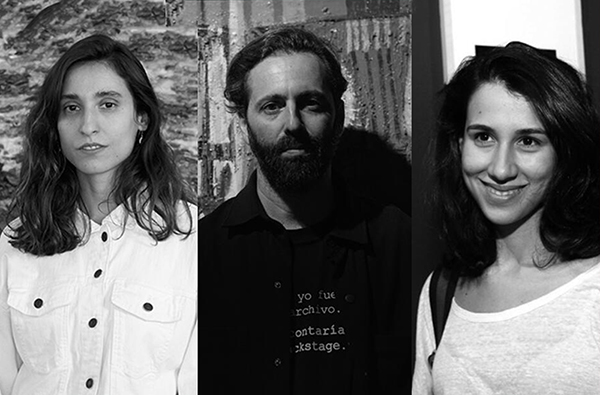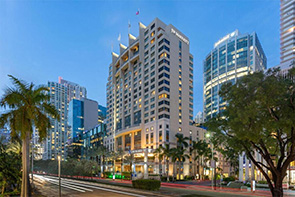Agustín Cárdenas (Cuba, 1927–2001)
Escultor esencial del arte moderno, Agustín Cárdenas es reconocido por sus formas orgánicas, sensuales y profundamente simbólicas. Influido por el surrealismo parisino y las raíces afrocubanas, su obra combina curvas fluidas, cuerpos totémicos y un sentido de armonía casi ritual. Cárdenas logró transformar la madera y el mármol en presencias vivas, cargadas de espiritualidad y misterio.
Ahmed Al Bahrani (Irak, 1965)
Escultor contemporáneo de proyección internacional, Ahmed Al Bahrani trabaja con materiales como bronce, acero y resinas para explorar temas de identidad, memoria y humanidad en crisis. Su obra a menudo aborda conflictos sociopolíticos desde una perspectiva poética, utilizando la monumentalidad y la figura humana como medios para reimaginar la condición contemporánea en el mundo árabe y más allá.
Amanda Valle (República Dominicana, 1984)
Pintora caribeña cuya obra oscila entre la abstracción emocional y la figuración evocadora. Los colores intensos, las capas atmosféricas y la gestualidad intuitiva definen un lenguaje propio que explora el subconsciente, la identidad y la energía espiritual del cuerpo. Valle crea atmósferas que funcionan como paisajes internos donde lo íntimo y lo simbólico convergen.
Amelia Peláez (Cuba, 1896–1968)
Figura clave de la vanguardia cubana, Amelia Peláez fusionó modernismo europeo, ornamentación colonial y tradición popular caribeña. Sus composiciones vibrantes —llenas de vitrales, patrones geométricos y elementos domésticos— celebran la cultura criolla desde una estética cubista tropical. Su estilo es inconfundible: exuberante, arquitectónico y profundamente identitario.
Ángel Acosta León (Cuba, 1930–1964)
Conocido por su expresión inquietante y visceral, Acosta León desarrolló un imaginario fantástico poblado de máquinas, híbridos y figuras distorsionadas. Su obra refleja una sensibilidad profundamente existencial, marcada por la angustia, el deseo y la búsqueda espiritual. Considerado un artista de culto, su pintura funciona como un diario simbólico de perturbadora belleza.
Beatriz Milhazes (Brasil, 1960)
Una de las artistas brasileñas más influyentes de nuestro tiempo, Milhazes es conocida por sus composiciones exuberantes llenas de color, ritmo y ornamentación. Su lenguaje mezcla modernismo, cultura tropical, artes decorativas y geometría, generando pinturas que vibran entre la abstracción y el diseño. Su obra es un carnaval visual de capas, patrones y movimiento.
Betsabeé Romero (México, 1963)
Artista visual y activista cultural, Romero trabaja con objetos cotidianos —como neumáticos, autos, textiles y símbolos populares— para hablar sobre migración, frontera, cultura urbana y memoria colectiva. Su obra combina tradición artesanal mexicana con crítica social contemporánea, transformando materiales comunes en poderosos artefactos poéticos.
Carlos Alfonzo (Cuba/Estados Unidos, 1950–1991)
Pintor fundamental del arte latino en EE.UU., Alfonzo creó un lenguaje pictórico intenso y visceral marcado por la espiritualidad, el exilio, la iconografía afrocaribeña y el expresionismo. Sus obras, cargadas de símbolos, trazos enérgicos y emocionales, se convirtieron en una expresión profunda de identidad, fragilidad humana y resistencia, especialmente durante la crisis del sida.
Carlos Anesi (Argentina, 1959)
Pintor y escultor argentino cuya obra explora la abstracción lírica y la energía del gesto. Anesi trabaja con capas dinámicas, colores vibrantes y texturas matéricas que evocan movimiento y expansión. Su lenguaje pictórico conecta la intuición, la naturaleza y una sensibilidad poética profundamente contemporánea.
Carlos Cruz-Diez (Venezuela/Francia, 1923–2019)
Uno de los grandes maestros del arte cinético. Cruz-Diez revolucionó la percepción del color mediante estructuras modulares y dispositivos visuales que generan vibración, movimiento y participación del espectador. Su obra propone que el color es autónomo: una experiencia viva que se despliega en el tiempo y en el espacio.
Carolina Antoniadis (Argentina, 1961)
Artista argentina reconocida por sus composiciones ornamentales llenas de patrones, textiles y símbolos domésticos. Su obra revaloriza el mundo cotidiano desde una estética pop y femenina, integrando diseño, memoria y cultura visual. Antoniadis crea universos coloridos donde lo decorativo adquiere fuerza conceptual.
Chiara Mecozzi (Italia, 1988)
Artista contemporánea cuya obra combina lo simbólico y lo emocional desde un lenguaje íntimo. Mecozzi trabaja con pintura y dibujo para construir atmósferas delicadas, figuras poéticas y paisajes interiores que dialogan con el cuerpo, la memoria y la vulnerabilidad humana. Su estilo se distingue por la sensibilidad y la quietud narrativa.
Claudio Bravo (Chile/Marruecos, 1936–2011)
Maestro del realismo contemporáneo, Bravo es célebre por sus retratos y naturalezas muertas de precisión magistral. Su obra combina virtuosismo técnico, profundidad psicológica y una atmósfera casi mística. Con telas arrugadas, papeles, objetos cotidianos y escenas íntimas, Bravo llevó el realismo a una dimensión espiritual.
Diego Rivera (México, 1886–1957)
Figura monumental del muralismo mexicano. Rivera fusionó historia, política, identidad indígena y lucha social en murales de enorme potencia visual. Su lenguaje combina modernismo europeo, estética precolombina y narrativas populares para construir un arte al servicio del pueblo y de la memoria colectiva.
Dino Bruzzone (Argentina, 1934–1995)
Artista argentino destacado por sus exploraciones geométricas y su aproximación al constructivismo. Bruzzone trabajó con formas puras, ritmos visuales y una paleta refinada para crear estructuras pictóricas que proponen equilibrio, orden y musicalidad. Su obra es un puente entre la tradición moderna y la abstracción latinoamericana.
Emilio Pettoruti (Argentina, 1892–1971)
Pionero de la modernidad en Argentina, Pettoruti integró cubismo, futurismo y ritmos musicales en composiciones geométricas luminosas. Su obra renovó la pintura rioplatense con una visión cosmopolita donde la luz, la transparencia y la estructura compositiva se vuelven protagonistas.
Enio Iommi (Argentina, 1926–2013)
Escultor fundamental del arte concreto, Iommi desarrolló una obra basada en líneas, planos y estructuras que desafían la gravedad. Su investigación sobre el espacio, el equilibrio y la tensión lo convierte en un referente indispensable de la abstracción latinoamericana. Sus piezas revelan precisión, rigor y una poética del vacío.
Fernando Botero (Colombia, 1932–2023)
Uno de los artistas latinoamericanos más reconocidos del mundo. Botero creó un estilo inconfundible basado en volúmenes expansivos que celebran la sensualidad, la ironía y el carácter humano. Sus figuras exageradas no buscan realismo físico, sino expresar poder, fragilidad, comedia y barroquismo.
Francis Alÿs (Bélgica/México, 1959)
Artista conceptual cuya práctica mezcla performance, documentación, urbanismo y narrativa poética. Alÿs trabaja caminando, interviniendo espacios y activando situaciones mínimas que revelan tensiones sociales, políticas y geográficas. Su obra es una reflexión sensible sobre el territorio y la condición contemporánea.
Frank Stella (Estados Unidos, 1936–2024)
Figura clave del minimalismo y la abstracción postpictórica. Stella eliminó la ilusión espacial para centrarse en la forma pura, los colores directos y las estructuras geométricas. Con sus “shaped canvases”, relieves y obras arquitectónicas, expandió los límites de la pintura hacia un territorio escultórico y monumental.
Guido Albi-Marini (Argentina, 1979)
Artista argentino cuya obra fusiona abstracción, gesto y exploración matérico-simbólica. Albi-Marini trabaja con capas de pintura, transparencias y ritmos visuales que evocan paisajes interiores y expansiones emocionales. Su lenguaje combina sutileza cromática y energía estructural, creando superficies vibrantes que funcionan como territorios sensoriales.
Guillermo Kuitca (Argentina, 1961)
Uno de los artistas más influyentes de Latinoamérica. Kuitca utiliza mapas, planos arquitectónicos, teatros y diagramas para explorar memoria, desplazamiento y teatralidad. Sus pinturas, cargadas de ambigüedad espacial, revelan una poética del tránsito y la distancia, convirtiendo la geografía en un espejo psicológico.
Guillermo Muñoz-Vera (Chile/España, 1956)
Maestro del realismo contemporáneo, Muñoz-Vera combina rigor técnico y reflexión conceptual. Sus obras representan objetos cotidianos, paisajes y escenas cargadas de símbolos históricos, jugando con la luz y la composición para transmitir una mirada crítica sobre la cultura, la ciencia y el paso del tiempo.
Harold Ancart (Bélgica, 1980)
Artista belga cuya obra abarca pintura, dibujo e instalación. Ancart se inspira en paisajes, estructuras urbanas y formas elementales, creando imágenes minimalistas atravesadas por color intenso y una sensibilidad meditativa. Sus superficies sugieren lugares abiertos, atmósferas ambiguas y una poética del silencio.
Henri Matisse (Francia, 1869–1954)
Figura central del arte moderno y creador del fauvismo. Matisse exploró el color como fuerza expresiva autónoma, desarrollando un lenguaje luminoso, ornamental y profundamente vital. Desde sus pinturas vibrantes hasta sus célebres “cut-outs”, su obra celebra la alegría, la forma pura y la armonía visual.
Jesús Rafael Soto (Venezuela/Francia, 1923–2005)
Uno de los pioneros del arte cinético y óptico. Soto investigó vibraciones visuales, percepción y movimiento real mediante estructuras suspendidas, líneas tensas y juegos de profundidad. Su obra transforma al espectador en participante activo, revelando la inestabilidad del espacio y la naturaleza vibrante del color.
John Henry (Estados Unidos, 1943–2022)
Escultor estadounidense reconocido por sus monumentales estructuras de acero. Henry construyó composiciones geométricas que desafían la gravedad, dialogan con el espacio urbano y transmiten tensión, equilibrio y energía arquitectónica. Su obra es emblemática dentro del minimalismo escultórico norteamericano.
Julio Larraz (Cuba/Estados Unidos, 1944)
Pintor célebre por su narrativa poética, humor sutil y escenarios enigmáticos. Larraz combina virtuosismo técnico con escenas cargadas de misterio: cielos amplios, personajes en silencio, arquitectura luminosa. Su obra revela un universo metafórico donde lo cotidiano se vuelve teatral y profundamente evocador.
Loie Hollowell (Estados Unidos, 1983)
Artista contemporánea que explora cuerpo, sexualidad, maternidad y espiritualidad mediante abstracciones biomórficas. Hollowell utiliza relieve, color vibrante y geometrías simétricas para crear pinturas-esculturas que evocan portales, energía vital y estados meditativos. Su obra es intensa, física y trascendental.
Manolo Valdés (España, 1942)
Artista español de proyección internacional. Valdés reinterpreta íconos de la historia del arte mediante obras monumentales que combinan tradición y contemporaneidad. Sus esculturas y pinturas destacan por su fuerza material, su sentido de presencia y una estética que celebra la memoria visual europea con lenguaje propio.
Manuel Mendive (Cuba, 1944)
Figura fundamental del arte afrocaribeño. Mendive fusiona espiritualidad yoruba, naturaleza, ritualidad y vida cotidiana en pinturas, performances y esculturas de gran vitalidad. Su obra conecta cuerpo, cosmos y ancestralidad, generando una poética visual profundamente ligada a raíces culturales y energías místicas.
Marcos Amaro (Brasil, 1984)
Artista interdisciplinario que explora la transformación, el ensamblaje y el diálogo entre arte, industria y memoria material. Amaro trabaja con fragmentos de máquinas, aviones, estructuras metálicas y restos industriales para construir esculturas que reflexionan sobre desgaste, reconstrucción y nuevas formas de habitar el mundo material.
Mario Carreño (Cuba/Chile, 1913–1999)
Figura esencial de la modernidad latinoamericana, Carreño combinó geometría, simbolismo caribeño y una profunda preocupación por la forma humana. Su obra atraviesa desde el surrealismo y la abstracción hasta composiciones neocubistas que celebran ritmo, color y estructura. Su legado es un puente entre tradición insular y vanguardia continental.
Martin Kippenberger (Alemania, 1953–1997)
Artista irreverente y prolífico, Kippenberger desarrolló una obra que desafiaba convenciones del mercado, del gusto y del sistema del arte. Su práctica abarcó pintura, instalación, escultura y performance, siempre con humor ácido, crítica institucional y una energía caótica que lo consagró como icono del arte posmoderno europeo.
Mike Kelley (Estados Unidos, 1954–2012)
Uno de los artistas conceptuales más influyentes de su generación. Kelley exploró memoria, trauma, cultura pop, educación y sistemas de poder mediante instalaciones, videos, performances y objetos cargados de ironía. Su obra es intensa, crítica y profundamente autobiográfica, revelando fracturas culturales y psicológicas de la vida contemporánea.
Mikhail Baryshnikov (Letonia/Estados Unidos, 1948)
Reconocido principalmente como uno de los grandes bailarines del siglo XX, Baryshnikov también ha desarrollado una práctica fotográfica incisiva. Sus imágenes capturan movimiento, emoción y presencia escénica con una sensibilidad coreográfica. Su mirada combina precisión, intimidad y el profundo entendimiento de la energía corporal.
Olafur Eliasson (Dinamarca/Islandia, 1967)
Artista contemporáneo conocido por sus obras inmersivas que investigan percepción, naturaleza, luz y clima. Eliasson trabaja a gran escala creando instalaciones que transforman el espacio y la experiencia sensorial. Su obra conecta arte, ciencia y ecología, invitando al espectador a reflexionar sobre el entorno y la conciencia colectiva.
Olga Sinclair (Panamá, 1957)
Pintora panameña de reconocimiento internacional, Sinclair desarrolla una obra expresionista y emotiva, centrada en la figura humana y en el gesto. Sus composiciones, vibrantes y enérgicas, transmiten intensidad emocional y una sensibilidad que conecta lo íntimo con lo universal. También destaca por su labor cultural y educativa.
Omar Rayo (Colombia, 1928–2010)
Maestro de la abstracción geométrica latinoamericana. Rayo trabajó con líneas, contrastes ópticos y estructuras rítmicas que generan ilusiones de profundidad y movimiento. Su estética, precisa y elegante, combina tradición precolombina, modernismo y una sensibilidad gráfica única que lo convierte en un referente continental.
OSGEMEOS (Brasil, 1974)
Dúo de gemelos artistas, Gustavo y Otávio Pandolfo, conocidos mundialmente por su estilo distintivo dentro del arte urbano. Sus obras mezclan fantasía, cultura popular brasileña, música, sueños y crítica social. Con personajes amarillos y escenarios oníricos, OSGEMEOS han expandido el graffiti hacia una dimensión poética y monumental.
Oswaldo Vigas (Venezuela, 1926–2014)
Artista clave del modernismo venezolano, Vigas integró mitología prehispánica, geometría y expresionismo en un lenguaje propio. Sus figuras arcaicas y composiciones poderosas reflejan una búsqueda profunda de identidad latinoamericana, marcada por la síntesis entre tradición ancestral y abstracción contemporánea.
Pablo Atchugarry (Uruguay, 1954)
Escultor reconocido por sus obras en mármol blanco, donde la luz y la verticalidad crean una sensación de ascenso espiritual. Atchugarry transforma la piedra en formas ondulantes, delicadas y casi etéreas, explorando pureza, dinamismo y trascendencia. Su técnica impecable y su poética formal lo distinguen en la escultura contemporánea.
Pedro Álvarez (Cuba, 1967–2004)
Pintor cubano cuya obra fusiona cultura pop, iconografía soviética, propaganda revolucionaria y sátira caribeña. Álvarez utilizó collage visual y humor crítico para reflexionar sobre política, historia y memoria colectiva en tiempos de transición. Su estilo vibrante y narrativo lo convirtió en una voz singular dentro del arte cubano contemporáneo.
Pedro Figari (Uruguay, 1861–1938)
Figura fundamental del arte rioplatense. Figari representó escenas populares, carnavales, bailes y tradiciones afro-uruguayas mediante pinceladas rápidas, luz cálida y una mirada humanista. Su estilo naïf-expresivo captura la vida cotidiana con poesía y sensibilidad histórica, convirtiéndolo en un cronista visual del espíritu cultural del Uruguay.
Peter Fischli & David Weiss (Suiza, activos como dúo 1979–2012)
Dúo icónico del arte contemporáneo, Fischli & Weiss exploraron lo absurdo, lo cotidiano y lo maravilloso escondido en lo simple. Su obra —videos, esculturas, fotografías y objetos improvisados— combina humor, precisión conceptual y una sensibilidad poética que cuestiona la lógica del mundo moderno. Su legado sigue influyendo la idea de “lo extraordinario en lo ordinario”.
Rachel Valdés (Cuba, 1990)
Artista multidisciplinaria centrada en la percepción, la luz y la relación entre cuerpo y espacio. Valdés crea instalaciones, esculturas y pinturas que generan experiencias inmersivas con transparencias, reflejos y color. Su obra invita al espectador a reconfigurar su percepción del entorno y su estado emocional.
Ricardo Cisneros (República Dominicana, 1971)
Artista visual que investiga la fluidez del color, la materia y la memoria. Su obra pictórica se caracteriza por capas atmosféricas, gestos libres y composiciones que evocan paisajes internos. Cisneros combina sensibilidad caribeña con abstracción contemporánea, generando un lenguaje visual introspectivo y meditativo.
Richard Hudson (Reino Unido, 1953)
Escultor reconocido por sus formas orgánicas, sensuales y monumentales, generalmente en acero pulido o bronce. Hudson explora la curva como símbolo de energía vital y conexión humana. Sus piezas reflejan elegancia fluida, minimalismo y una fuerte presencia física en el espacio público.
Robert Indiana (Estados Unidos, 1928–2018)
Figura central del Pop Art. Indiana transformó palabras, números y símbolos en potentes íconos culturales, incluyendo su célebre obra LOVE. Su trabajo combina gráfica, política y espiritualidad, haciendo de la tipografía un vehículo para reflexionar sobre identidad nacional, deseo y esperanza.
Roberto Matta (Chile, 1911–2002)
Uno de los maestros del surrealismo. Matta desarrolló “morfologías psicológicas” donde figuras, paisajes y energías cósmicas se mezclan en composiciones expansivas. Su pintura expresa caos, transformación y fuerzas internas, conectando subconsciente, política y metafísica en un lenguaje único.
Rufino Tamayo (México, 1899–1991)
Maestro del arte moderno mexicano, Tamayo unió tradición indígena, modernismo y color intenso en pinturas de profunda síntesis plástica. Sus figuras y símbolos evocan lo ancestral sin perder fuerza contemporánea. Su obra destaca por su equilibrio entre identidad cultural y universalidad.
Sophia Vari (Grecia, 1940–2022)
Escultora griego-colombiana conocida por sus formas volumétricas, curvas clásicas y sentido escultórico de la elegancia. Vari trabajó principalmente en bronce y mármol, creando piezas que combinan armonía matemática, sensualidad y un refinado diálogo con la historia del arte mediterráneo.
Soraya Abu Naba’a (República Dominicana, 1979)
Artista multidisciplinaria que explora identidad, cuerpo femenino y espiritualidad a través de pintura, fotografía e instalación. Su obra combina fuerza emocional, poética visual y un lenguaje cargado de simbolismos que reflexionan sobre fragilidad, resiliencia y transformación.
Tania Bruguera (Cuba/Estados Unidos, 1968)
Figura clave del arte político y del “arte útil”. Bruguera trabaja con performance, activismo, inmersión comunitaria e instituciones para confrontar poder, censura y derechos humanos. Su obra es intensa, directa y profundamente comprometida con la transformación social y la participación ciudadana.
Victor Vasarely (Hungría/Francia, 1906–1997)
Pionero del arte óptico. Vasarely transformó geometría, color y repetición en vibraciones visuales que cuestionan la percepción. Su obra combina ciencia, diseño y abstracción para crear ilusiones dinámicas que siguen influyendo el arte digital y la cultura visual contemporánea.
Vik Muniz (Brasil/Estados Unidos, 1961)
Artista internacionalmente reconocido por sus imágenes construidas con materiales inesperados —azúcar, basuras, recortes, polvo, pigmentos— antes de ser fotografiadas. Muniz juega con lo real y lo representado, creando obras ingeniosas que reflexionan sobre memoria, imagen y construcción cultural.
Wifredo Lam (Cuba, 1902–1982)
Maestro del modernismo global. Lam fusionó surrealismo, simbolismo afrocubano, modernismo europeo y mitología caribeña en un lenguaje híbrido y poderoso. Sus figuras totémicas y paisajes oníricos expresan sincretismo cultural, resistencia y espiritualidad, consolidándolo como uno de los artistas más influyentes del siglo XX.

































